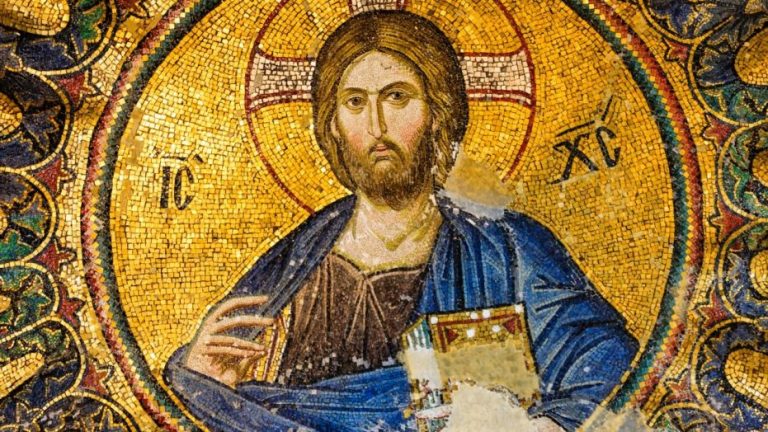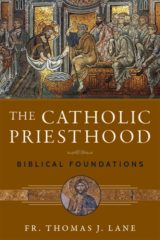By Fr. Thomas J. Lane
Fr. Thomas J. Lane is a priest of the Diocese of Cloyne (Ireland) and is Assistant Professor of Sacred Scripture at Mount St. Mary’s Seminary, Emmitsburg, Maryland. He is the author of The Catholic Priesthood: Biblical Foundations.

Jesus went to Calvary wearing a seamless undergarment or tunic, woven from top to bottom, beneath his outer garments (John 19:23). John sees great significance in this seamless robe, because he states in 19:23 that it was “seamless” and, at the end of 19:23, that it was “in one piece” (διʼ ὅλου), though the latter is not obvious in all English translations. It certainly was a unique garment, because the tunic worn daily by men and women in Palestine was not seamless but made of two pieces of fabric sown together.
John does not tell us the meaning of the symbolism but leaves it up to the reader to work it out. It is often taken to symbolize the unity of the Church, and certainly tearing a garment by a prophet was seen as a sign of disunity (see 1 Kings 11:29–33). I think we can also see it symbolizing Jesus’ priesthood, the transfiguration of the Levitical priesthood. Admittedly, this is not without difficulties because of the word chitōn (χιτών), which John uses in 19:23 to describe Jesus’ garment. The high priest wore two full length garments, the tunic/ undergarment worn by all priests and, additionally, his priestly robe (or the ephod). Chitōn is the word in the Greek Old Testament for the tunic/undergarment worn by all priests, while a different word, hypodytēs (ὑποδύτης), is usually the word for the priestly robe. However, I believe there are possible ways around this difficulty.
Firstly, the wider context in John’s Gospel. Although the letter to the Hebrews is the only New Testament document describing Jesus as high priest, the Gospel of John also applies priestly theology to Jesus. Therefore, it would not be out of place in John to expect to see priestly associations in Jesus’ Passion.
Secondly, it would have been impossible for Jesus to wear a high priest’s robe on the way to the Cross because he himself would never have been able to enter the priests’ courtyard in the temple and no priest would ever remove the high priest’s robe from its place inside the temple. The most the evangelist could do is make an association between the way Jesus went dressed to the Cross and the priestly garment of the high priest. How does John do this? The word hypodytēs in the Greek Old Testament for the high priest’s robe literally means an undergarment, because it was worn under the high priest’s ephod. Jesus’ tunic was the garment he wore under his other clothes, which the soldiers took from him first (John 19:23). Those who doubt the priestly symbolism in Jesus’ tunic in John 19:23 associate Jesus’ tunic with the high priest’s tunic (chitōn) rather than the high priest’s robe (hypodytēs). I would like to suggest that we consider associating Jesus’ chitōn in John 19:23 with the hypodytēs or high priestly robe because Jesus wore his tunic under his other garments and the high priest wore his hypodytēs under the ephod.
Thirdly, John 19:23 tells us Jesus’ tunic was seamless, and although the Old Testament does not tell us the high priest’s robe was seamless, Josephus does: “Now this vesture was not composed of two pieces, nor was it sewed together upon the shoulders and the sides, but it was one long vestment so woven as to have an aperture for the neck.” The mere fact that the daily tunic worn by everyone and the tunic worn by the high priest under his priestly robe are also called chitōn does not compel us to associate Jesus’ garment with them. To me it makes more sense to associate Jesus’ seamless garment instead with the high priest’s robe, which was also seamless. Ratzinger25 also regards the reference to Jesus’ tunic being seamless as signifying a high priestly undertone, especially in view of John 17: “we may detect in the evangelist’s passing reference an allusion to Jesus’ high-priestly dignity, which John had expounded theologically in the high-priestly prayer of chapter 17. Not only is this dying man Israel’s true king: he is also the high priest who accomplishes his high-priestly ministry precisely in this hour of his most extreme dishonor.”
Fourthly, John 19:24 tells us that the soldiers did not tear Jesus’ robe. Exodus 28:32 forbade the tearing of the high priest’s robe. Since everyone in Palestine wore a chitōn daily, saying Jesus went to his Passion wearing a chitōn would not have special significance, but saying that Jesus went to his Passion wearing a chitōn having two qualities similar to the robe of the high priest—seamless and not torn—allows us to see it containing symbolism associating it with the high priest’s garment.
Fifthly, John points out another quality of Jesus’ tunic in 19:23: it was woven from top to bottom, anōthen (ἄνωθεν). This word anōthen has great significance when used elsewhere in John. In John 3:31, Jesus is the one who comes from above (anōthen), and in 19:11 Pilate would have no power over Jesus were it not given him from above (anōthen). Both Matthew 27:51 and Mark 15:38 tell us the curtain in the temple was torn in two from top to bottom (anōthen) when Jesus died. These usages of the word anōthen indicate divine origin: Pilate’s power has been given him by God and the curtain in the temple is torn by God. Surely it is not by chance that John 19:23 tells us Jesus’ chitōn was woven from top to bottom (anōthen). It must mean something. This garment is not just any garment, but is drawing attention to some divine connection.
You Might Also Like

During the time of Jesus Christ, neither he nor his apostles would have had the term “priest” applied to their mission or identity. The priesthood was exclusive to the tribe of Levi and at that time was associated primarily with their sacrificial liturgies in the temple. But with Christ’s death on the Cross, a new understanding of Christ as priest began to grow in light of his priestly self-sacrifice. The Catholic Priesthood: Biblical Foundations by Fr. Thomas Lane highlights the Scriptural evidence indicating that Christ’s intention was to establish a New Covenant priesthood that he would share with his apostles and their successors.

